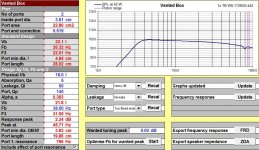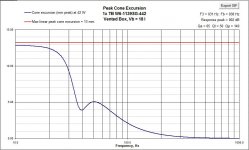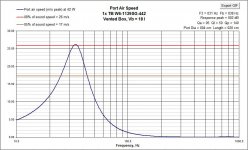Us regulars tend to get to know each other... 😀
Wolfie is a very safe and experienced pair of hands:
My intuition of 6" woofers, is they like about 20 Litres, here due to a Qts of 0.4 in reflex.
But that woofer is definitely in the sub-woofer category. Hence Wolfie says cross it low. I think it's the tiny mid that will struggle with this. Why I suggested doubling up the mids.
I hear you. You're probably right, but I'll burn that bridge once I cross it ;-)
I'll take Wolf's advice into account and will probably end up following it.
I've actually read a *lot* of his posts regarding the 1139SIF in my Google research phase before starting this project.
(I've read a *lot* of your posts as well in the past years by the way 🙂)
I was originally kind of inspired by the Philharmonics BMR monitor which uses this same exact BMR driver:
Salk Sound
I do understand that Phil's design is very thought out and I don't have much chance of getting anywhere near it's performance, but I wanted to try this setup because it's exactly what I had in mind after I built my Needle Deluxe's with the 4" Tang Bands.
"Wow! This sounds good, but I need more low-end, better horizontal dispersion, and maybe better defined highs. It doesn't need to be loud though." 🙂
Also I really want to hobby around with the budget friendly DSP boards that have become available by Sure/Wondom, and I think that will help me a lot compared to havind to do it with analog filters / crossovers.
If after simulating and experimenting I find the one BMR won't cut it, I'll double up!
Do you happen to have any feedback on my previous post with my first WinISD simulations for a sealed cabinet with Linkwitz transform?
Last edited:
I have heard the Scan 18W/8545 in some superb, cost no object systems!
I call it the scruffy looking Scan. But quite superb below 2kHz.
Craig at Selah Audio gets annoyed when I show his great speaker without a credit. But here's to you, Craig. Be kind. We are in the business of giving something back.
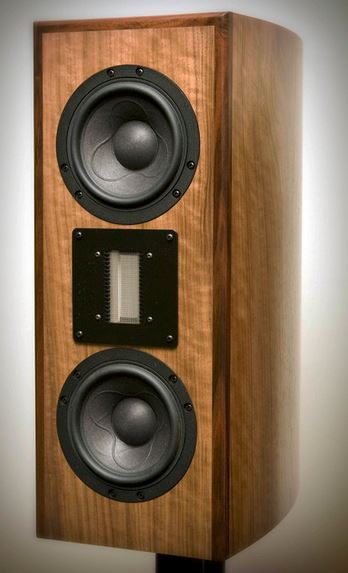
TBH, I think you have made a poor design choice with YOUR woofer. Salk can cross much higher:
Salk Sound
So with Salk's design, the little mid doubtless is more in it's comfort zone. But I assure you this is true. Wire two mids in series and you get the same SPL, lower distortion, an 8 ohm impedance and it might work very nicely. 😎
I call it the scruffy looking Scan. But quite superb below 2kHz.
Craig at Selah Audio gets annoyed when I show his great speaker without a credit. But here's to you, Craig. Be kind. We are in the business of giving something back.
TBH, I think you have made a poor design choice with YOUR woofer. Salk can cross much higher:
Salk Sound
So with Salk's design, the little mid doubtless is more in it's comfort zone. But I assure you this is true. Wire two mids in series and you get the same SPL, lower distortion, an 8 ohm impedance and it might work very nicely. 😎
Last edited:
All right, point taken - as I said, "I will be told I'm using the wrong parts and I'm fine with that - it's a learning experience" 🙂
The Philharmonic BMR monitors do have their crossover at 600hz I just found out.
Do you happen to have any feedback on my previous post (few posts back) with my first WinISD simulations for a sealed cabinet with Linkwitz transform?
I badly need advice on my first WinISD adventures.. There's so much I don't know so I'm stabbing in the dark here.
The Philharmonic BMR monitors do have their crossover at 600hz I just found out.
Do you happen to have any feedback on my previous post (few posts back) with my first WinISD simulations for a sealed cabinet with Linkwitz transform?
I badly need advice on my first WinISD adventures.. There's so much I don't know so I'm stabbing in the dark here.
Edit:
Wolfie said:
The Philharmonics have their crossover at 600hz. So considering Wolf's statement, it might just work out I think?
Wolfie said:
The 1139 rolls off just shy of 600Hz on its own. The TE midbass (if used in a 3-way with said 1139) should be happy to take advantage of this rolloff and take some stress away from it in terms of Xmax. I would wager 400-600 is a better transitional point for a 3" to 6" for tonal balance. If you were to use the TE lower, the midrange would not have the weight required to flesh out the range and sound a bit thin.
The Philharmonics have their crossover at 600hz. So considering Wolf's statement, it might just work out I think?
I was just reviewing Selah Audio and Salk speakers. Certainly a lot to like with both companies, and should we say, their leading engineers! 🙂
What I know, and most everybody else, is three ways work better than two ways.
My current theory, and it actually goes back a long way in telephone theory, is the 300-3kHz range is crucial for intelliigabilty on human voices.
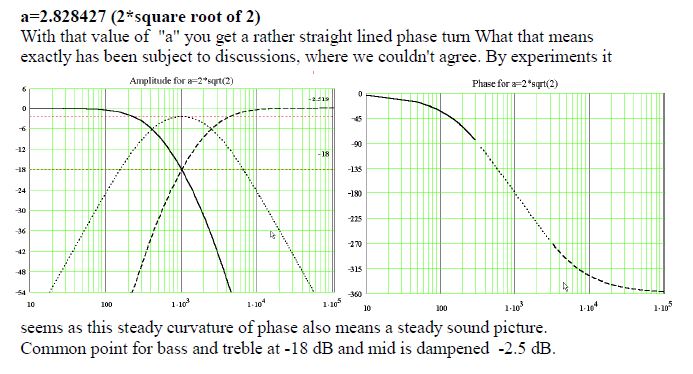
Two ways are more problematic:
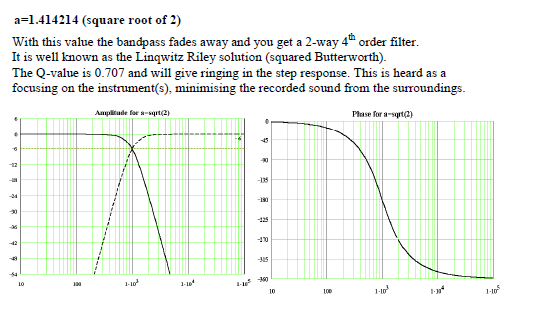
This is just Fourier Transform mathematical theory. What it doesn't tell you about is power response. Linkwitz-Riley is a bit weak on power response. My feeling here is just to get on with building this baby. But I do think a 4 ohm mid is a problem in a three way. Leads to amp-destroying low impedance in my experience.
What I know, and most everybody else, is three ways work better than two ways.
My current theory, and it actually goes back a long way in telephone theory, is the 300-3kHz range is crucial for intelliigabilty on human voices.
Two ways are more problematic:
This is just Fourier Transform mathematical theory. What it doesn't tell you about is power response. Linkwitz-Riley is a bit weak on power response. My feeling here is just to get on with building this baby. But I do think a 4 ohm mid is a problem in a three way. Leads to amp-destroying low impedance in my experience.
My current theory, and it actually goes back a long way in telephone theory, is the 300-3kHz range is crucial for intelliigabilty on human voices.
YES.
That's exactly why I started this project. I have amazing 2-way Samuel HQ speakers that really sound awesome, and I have 2 simple Needles with Tang Band 1320SIF full range drivers.
And for jazz / singer-songwriter music, I found that the full range speakers have a clarity / point source / "togetherness" that the big speakers might just not have, eventhough the Samuels really do sound awesome for almost anything I throw at them.
That's what got me on the track of wanting to build a speaker with no crossover in the vocal range - or at least, as much out of it as possible.
So I figured I'd use what I loved - a full range driver - and just add some sprinkles up top, and some tight boom real low.
My original idea was to take it to the extreme - 150-200hz low end crossover, >=7Khz high crossover.
And that's basically the idea of what I'm trying to do here, figuring everything out while I go along.
I will keep on building this baby, I might switch methods / parts / theories along the way though 🙂
Last edited:
AND- I was offering advice from having measured and used the 1139. The 1.25ft^3 box really allows it to do what it does best. The specs don't differ much from spec sheet, but give more insight into how it can be used. It's a versatile woofer!
...and Steve, with regard to Selah Audio....
His name is Rick Craig, so Craig is his last name.
For more info- Salk uses designers like Jeff B and Dennis Murphy to get the job done right. Rick has been doing it about as long as either of them, so he's really good at it too. I've met all 4 of those guys in the past, and respect all of them.
Later,
Wolf
...and Steve, with regard to Selah Audio....
His name is Rick Craig, so Craig is his last name.
For more info- Salk uses designers like Jeff B and Dennis Murphy to get the job done right. Rick has been doing it about as long as either of them, so he's really good at it too. I've met all 4 of those guys in the past, and respect all of them.
Later,
Wolf
AND- I was offering advice from having measured and used the 1139. The 1.25ft^3 box really allows it to do what it does best.
Noted!
But 35 liter is a bit big for my use case so I am forced to investigate what I can do with less..
Our living room and kitchen are supplied with 6 DIY speakers by now, this new project will have to go to the bedroom :-/
Which is why they don't need to be LOUD - I want to get the best at moderate volume..
Okay, you can use it anywhere from 0.4ft^3 to 3ft^3. Like I said- it's versatile!
A 1ft^3 box can still provide ample low-end. I just would not run it sealed as you'll stifle its abilities down low without using a lot of EQ; read: +6dB, or 4x the power.
Later,
Wolf
A 1ft^3 box can still provide ample low-end. I just would not run it sealed as you'll stifle its abilities down low without using a lot of EQ; read: +6dB, or 4x the power.
Later,
Wolf
Okay, you can use it anywhere from 0.4ft^3 to 3ft^3. Like I said- it's versatile!
A 1ft^3 box can still provide ample low-end. I just would not run it sealed as you'll stifle its abilities down low without using a lot of EQ; read: +6dB, or 4x the power.
Later,
Wolf
I get that. The thing is that I'm new to all this and designing sealed seems to present much less problems than designing a ported cabinet.
My Google-Fu has shown me that the issue with the 1139SIF is that it's difficult to design a moderate-size cabinet with ports as the ports need to be really wide / long to avoid chuffing.
On the other hand, I'll be using DSP and class D amplifiers, so I should be able to pull off lots of DSP/PEQ using a 200W (or more!) class D amp per sub driver at <$80 cost per amp.
I'm considering using one 200W amp per 1139SIF, and maybe 30W / 50W / 100W per driver for the mid and high - class D really is doable that way I think.
A single TPA3116 2x50W could power the mid and high!
Or one 30W TPA3110 per mid/high driver, like this : WONDOM AA-AB31471 Class D Mono Amplifier Module TPA3110 30W 4 Ohm - Audiophonics
I mean, I could even throw in a TPA3255 480W amp per 1139SIF like these : TPA3255 1x480W 1Ch Class D Audio Amplifier | eBay
That should give me some EQ / DSP boost headroom, right?
Last edited:
What you are seeing is the quest to use the smallest cabinet (0.4-0.5ft^3) possible and still get sub-bass from the 1139. With this in mind- yes- the ports would need to be long and large and difficult to fit.
When you increase the volume of the box, this issue becomes less of a concern. Larger the box, the shorter the ports for the same diameter pipe. AND- if you use a little stuffing, the diameter minimum can be reduced as well. The ports I used in Icthus were 2x 1.75" diameter by about 7" long, but that is a 1.25ft^3 box. In a smaller box they will be longer, but if you don't need the smallest, they can fit without too much trouble.
What size box do you want to use? I know the mid you have in mind needs very little chamber to be happy, but I recommend about a liter total.
Later,
Wolf
When you increase the volume of the box, this issue becomes less of a concern. Larger the box, the shorter the ports for the same diameter pipe. AND- if you use a little stuffing, the diameter minimum can be reduced as well. The ports I used in Icthus were 2x 1.75" diameter by about 7" long, but that is a 1.25ft^3 box. In a smaller box they will be longer, but if you don't need the smallest, they can fit without too much trouble.
What size box do you want to use? I know the mid you have in mind needs very little chamber to be happy, but I recommend about a liter total.
Later,
Wolf
What you are seeing is the quest to use the smallest cabinet (0.4-0.5ft^3) possible and still get sub-bass from the 1139. With this in mind- yes- the ports would need to be long and large and difficult to fit.
When you increase the volume of the box, this issue becomes less of a concern. Larger the box, the shorter the ports for the same diameter pipe. AND- if you use a little stuffing, the diameter minimum can be reduced as well. The ports I used in Icthus were 2x 1.75" diameter by about 7" long, but that is a 1.25ft^3 box. In a smaller box they will be longer, but if you don't need the smallest, they can fit without too much trouble.
What size box do you want to use? I know the mid you have in mind needs very little chamber to be happy, but I recommend about a liter total.
Later,
Wolf
Let's say that the total size I have in mind would be the size of the Philharmonic BMR, which is about 30 liters I think.
BUT - If I can get away with less, I'd rather do so. (Which is why I did my first WinISD sim for a 12l box - just to see what I could get out of that)
So - since the issue seems to be cabinet volume vs amplifier power, I'm inclined to just throw more amplifier power at it, as I'm very fond of my current DIY TPA3116 class D amplifier that's driving my Samuel HQ's, sounding great.
$80 can buy me a 480Watt class D amplifier:
TPA3255 1x480W 1Ch Class D Audio Amplifier | eBay
so suppose I use one of those per 1139SIF driver.
And I add a TPA3116 or TPA3251/3252/3255 for the mids and highs.
I'd have LOTS of power to do EQ / DSP Gain. Right?
A few posts back I posted my WinISD sim giving me a 12l sealed cabinet with an F3 of 30Hz, when applying a Linkwitz transform.
All this needs is more amplifier power, as far as I've been able to figure out.
So why not throw relatively cheap class D TPA's at it?
Last edited:
So - since the issue seems to be cabinet volume vs amplifier power, I'm inclined to just throw more amplifier power at it?
No, not really. You can still hit about 30-35Hz in a 0.5ft^3 vented box. You would not require the extra power or boost to have extended bass. Why use more wattage, when the drivers will get there on their own without it?
I'm a passive guy, so I'll never understand the fascination with all the continuously adjustable active DSP filtration. I just would rather not.
Later,
Wolf
No, not really. You can still hit about 30-35Hz in a 0.5ft^3 vented box. You would not require the extra power or boost to have extended bass. Why use more wattage, when the drivers will get there on their own without it?
I'm a passive guy, so I'll never understand the fascination with all the continuously adjustable active DSP filtration. I just would rather not.
Later,
Wolf
If I don't have to I won't! 🙂
Can you hint me how to use the 1139SIF in a modest size cabinet (Say - 12 - 16 liter) to go down to 30Hz?
Keep in mind I'm just starting out - I fired up WinISD for the first time just 2 days ago 🙂
I'm still at the point where every hour I learn more about what I *don't* know :-/
Right now I just entereded "12 liter" in WinISD and tried to get as low as possible using LW xforms, which is probably the completely wrong way to go about this..
On the other hand my point still stands - with current events it's really easy /cheap to just throw class D amplifier power at it.
..and if that works, why would it not be a proper (modern) solution?
Last edited:
How about 18 ltrs for 30 Hz?
Using 2x 1.5"D ports, 8" long, tuned to 38Hz and yields an F3 of 30.48Hz. Use about 3/4# of stuffing, and flare both ends of the port if possible. This yields about 98dB before the port starts to chuff a bit. You could likely face them toward the rear and never hear them.
No need for boost. See below...
Wolf
Using 2x 1.5"D ports, 8" long, tuned to 38Hz and yields an F3 of 30.48Hz. Use about 3/4# of stuffing, and flare both ends of the port if possible. This yields about 98dB before the port starts to chuff a bit. You could likely face them toward the rear and never hear them.
No need for boost. See below...
Wolf
Attachments
Personally, I don't think hitting something with a bigger hammer is a modern solution.
Sure it is if bigger hammers have only recently become available 🙂
How about 18 ltrs for 30 Hz?
Using 2x 1.5"D ports, 8" long, tuned to 38Hz and yields an F3 of 30.48Hz. Use about 3/4# of stuffing, and flare both ends of the port if possible. This yields about 98dB before the port starts to chuff a bit. You could likely face them toward the rear and never hear them.
No need for boost. See below...
Wolf
That sounds good, thanks!!
Yes, but not 480W (into 2Ohm) as your sub is 4Ohm, you will get half. Half the power is only 3dB less, 10dB less would sound like half as loud.........
$80 can buy me a 480Watt class D amplifier:
TPA3255 1x480W 1Ch Class D Audio Amplifier | eBay
so suppose I use one of those per 1139SIF driver.
And I add a TPA3116 or TPA3251/3252/3255 for the mids and highs.
I'd have LOTS of power to do EQ / DSP Gain. Right?
You could drive 2 subs (in parallel) with that amp. Your sub does not need more power then where it reaches it's max excursion (xmax).
That looks fine, it is not only power, but also sensitivity (dB/W) that plays a roll in output.A few posts back I posted my WinISD sim giving me a 12l sealed cabinet with an F3 of 30Hz, when applying a Linkwitz transform.
All this needs is more amplifier power, as far as I've been able to figure out.
So why not throw relatively cheap class D TPA's at it?
A 12" will put out about as much low bass as 2x 8" or 4x 6" if they all have the same xmax.
2 subs will give better placement options, and thus SQ with less EQ.
The main things you can't EQ or DSP for, are bad speaker setup (combfiltering, phase issues) and off axis response (main speakers) compared to on axis as both will always change together.
If everything in your setup is right, you won't need much DSP, and really bad things you can't DSP to fix. A bit like make-up.

Yes, but not 480W (into 2Ohm) as your sub is 4Ohm, you will get half.
Still 240W though - that would be fine for my simulation with a 12l cabinet with LW xform.
If everything in your setup is right, you won't need much DSP, and really bad things you can't DSP to fix. A bit like make-up.
But DSP can help with things that used to be more difficult, like level-matching drivers, phase issues, baffle-step correction, and room correction.
It's not a fix for everything but it sure makes stuf a lot easier for people like me.
And since I'd want to use DSP for room correction anyway, I might as well use it for the rest too.
But as I said, I won't slap on more amp power if I don't *need* to.
I'll first have a look at Wolf's suggestions, and I might just get some scrap wood and try a few different things just to see what happens.
That's imho the beauty of class D amps and DSP - it's so cheap to just buy some stuff and experiment with!
I wouldn't try 6 different cabinets if I had to figure out analog crossovers and filters for each and solder them and hope I got it right for every cabinet. (Because I don't know anything about analog crossover design)
With DSP (and class D) I *can* easily try different cabinets and crossover settings and slap on more power just to see what happens. (And I have a decent amount of experience with DSP / Fourier transforms / audio code in the digital domain)
Last edited:
- Home
- Loudspeakers
- Multi-Way
- An idiot's blog to design and build speakers
